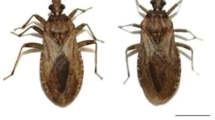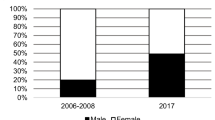Abstract
Polyploidisation is assumed to have played a significant role in the evolution of hybrid asexual lineages. The virtual absence of natural asexual systems in which more than a single ploidy level successfully establishes successful independent clonal lineages is generally explained by the strong effects of polyploidisation on fitness. Experimental crosses were made between diploid and triploid asexual Cobitis elongatoides × C. taenia hybrids (female) and both parental spined loach species (male). Genotyping of the progeny using allozymes and multilocus DNA fingerprinting, along with flow cytometric measurement of ploidy level, demonstrated the occurrence of gynogenetic reproduction in both female biotypes. The incorporation of the sperm genome occurred in some progeny, giving rise to a higher ploidy level, but the rate of polyploidisation differed significantly between the diploid and triploid females. These outcomes are consistent with the existence of developmental constraints on tetraploidy, which determine the rarity of tetraploids in natural populations. No cases of ploidy level reduction were observed. Since diploid and triploid hybrid populations occur where the lack of potential progenitor excludes the possibility of de novo origin, it is probable that both diploid and triploid females can establish successful clonal lineages. Spined loaches represent a unique example, among asexual vertebrates, where more than one ploidy level can establish persistent clonal lineages, which are reproductively independent of one another.




Similar content being viewed by others
References
Alves MJ, Coelho MM, Collares-Pereira MJ (2001) Evolution in action through hybridisation and polyploidy in an Iberian freshwater fish: a genetic review. Genetica 111:375–385
Arai A, Mukaino M (1997) Clonal nature of gynogenetically reproduced progeny of triploid loach, Misgurnus anguilicaudatus. J Exp Zool 278:412–421
Avise JC, Quattro JM, Vrijenhoek RC (1992) Molecular clones within organismal clones. Evol Biol 26:225–246
Beukeboom LW, Vrijenhoek RC (1998) Evolutionary genetics and ecology of sperm-dependent parthenogenesis. J Evol Biol 11:755–782
Bogart JP (1989) A mechanism for interspecific gene exchange via all-female salamander hybrids. In: Dawley RM, Bogart JP (eds) Evolution and ecology of unisexual vertebrates. Bulletin 466, New York State Museum, Albany, New York, pp 170–179
Bohlen J (1999) Reproduction of spined loach, Cobitis taenia, (Cypriniformes; Cobitidae) under laboratory conditions. J Appl Ichthyol 15:49–53
Bohlen J, Ráb P (2001) Species and hybrid richness in spined loaches of the genus Cobitis L. (Teleostei: Cobitidae.), with a checklist of European forms and suggestions for their conservation. J Fish Biol 59(Suppl A):79–85
Bohlen J, Ráb P, Šlechtová V, Rábová M, Ritterbusch D, Freyhof J (2002) Hybridogeneous biotypes in spined loaches (genus Cobitis) in Germany with implications for conservation. In: Collares-Pereira MJ, Coelho MM, Cowx IG (eds) Conservation of freshwater fishes: options for the future (chapter 28). Fishing News Books, Blackwell Science, Oxford, pp 311–321
Boroń A (2003) Karotypes and cytogenetic diversity of the genus Cobitis (Pisces, Cobitidae) in Poland: a review. Cytogenetic evidence for a hybrid origin of some Cobitis triploids. Folia Biologica (Krakow) 51(Suppl):49–54
Chevassus B, Guyomard R, Chourrout D, Quillet L (1983) Production of viable hybrids in salmonids by triploidisation. Genet Sel Evol 15:519–532
Culling MA, Janko K, Côté IM, Hewitt G (2006) European colonisation of the spined loach Cobitis taenia from Ponto-Caspian Refugia based on mitochondrial DNA variation. Mol Ecol 15:173–190
Goddard KA, Dawley RM, Dowling TE (1989) Origin and genetic relationships of diploid, triploid and diploid–triploid mosaic biotypes in the Phoxinus eos–neogaeus unisexual complex. In: Dawley RM, Bogart JP (eds) Evolution and ecology of unisexual vertebrates. Bulletin 466, New York State Museum, Albany, New York, pp 268–280
Graf JD, Polls-Pelaz M (1989) Evolutionary genetics of the Rana esculenta hybrid complex. In: Dawley RM, Bogart JP (eds) Evolution and ecology of unisexual vertebrates. Bulletin 466, New York State Museum, Albany, New York, pp 289–302
Guo SW, Thompson EA (1992) Performing the exact test of Hardy–Weinberg proportion for multiple alleles. Biometrics 48:361–372
Janko K, Kotlik P, Ráb P (2003) Evolutionary history of asexual hybrid loaches (Cobitis: Teleostie) inferred from phylogenetic analysis of mitochondrial DNA variation. J Evol Biol 16:1280–1287
Janko K, Ráb P, Culling MA, Kotlík P (2005) Ice age cloning—comparison of quaternary evolutionary histories of sexual and clonal forms of European loaches (Cobitis; Teleostei) using the analysis of mitochondrial DNA variation. Mol Ecol 14:2991–3004
Kim IS, Lee EH (2000) Hybridisation experiment of diploid–triploid cobitid fishes, Cobitis sinensis–longicorpus complex (Pisces, Cobitidae). Folia Zool 49(Suppl 1):17–22
Kondrashov AS (1997) Evolutionary genetics of life cycles. Annu Rev Ecol Syst 28:391–435
Kondrashow AS, Crow JF (1991) Haploidy or diploidy, which is better? Nature 351:314–315
Lampert KP, Lamatsch DK, Epplen JT, Schartl M (2005) Evidence for a monophyletic origin of triploid clones of the Amazon molly, Poecilia formosa. Evolution 59:881–889
Lynch M (1984) Destabilising hybridization, general purpose genotypes and geographic parthenogenesis. Quart Rev Biol 59:257–290
Moritz C, Brown WM, Densmore LD, Wright JW, Vyas D, Donnellan S, Adams M, Baverstock P (1989) Genetic diversity and the dynamics of hybrid parthenogenesis in Cnemidophorus (Teiidae) and Heteronotia (Gekkonidae). In: Dawley RM, Bogart JP (eds) Evolution and ecology of unisexual vertebrates. Bulletin 466, New York State Museum, Albany, New York, pp 268–280
Nanda I, Neitzel H, Sperling K, Studer R, Epplen JT (1988) Simple GACTA repeats characterize the X-chromosomal heterochromatin of Microtus agrestis, European field vole (Rodentia, cricetidae). Chromosoma 96:213–219
Nanda I, Schartl M, Feichtinger W, Schlupp I, Parzefall J, Schmid M (1995) Chromosomal evidence for laboratory synthesis of a triploid hybrid between the gynogenetic teleost Poecilia formosa and its host species. J Fish Biol 47:619–623
Otto FJ (1994) High resolution analysis of nuclear DNA employing the fluorochrome DAPI. In: Darzynkiewicz Z, Robinson JP, Crissman HA (eds) Flow cytometry, 2nd edn., Part A. Vol 41 of methods in cell biology. Academic Press, London, pp 211–217
Otto SP, Whitton J (2000) Polyploid incidence and evolution. Annu Rev Genet 34:401–437
Otto SP (2003) In polyploids, one plus one does not equals two. Trend Ecol Evol 18:431–433
Paquin CE, Adams J (1993) Frequency of fixation of adaptive mutations is higher in evolving diploid than haploid yeast populations. Nature 302:495–500
Prehn LM, Rasch EM (1969) Cytogenetic studies of Poecilia (Pisces). I. Chromosome numbers of naturally occurring poeciliid species and their hybrids from Eastern Mexico. Canad J Genet Cytol 11:880–895
Ráb P, Rábová M, Bohlen J, Lusk S (2000) Genetic differentiation of the two hybrid diploid–polyploid complexes of loaches, genus Cobitis (Cobitidae) involving C. taenia, C. elongatoides and C. spp. in the Czech Republic: karyotypes and cytogenetic diversity. Folia Zool 49(Suppl):55–66
Rasch EM, Darnell RM, Kallman KD, Abramoff P (1965) Cytophotometric evidence for triploidy in hybrids of the gynogenetic fish, Poecilia formosa. J Exp Zool. 160:155–169
Rasch EM, Balsano JS (1974) Biochemical and cytogenetic studies of Poecilia from eastern Mexico. II. Frequency, perpetuation, and probable origin of triploid genomes in females associated with Poecilia formosa. Reviste de biologia tropical 21:351–381
Saat TV (1991) Reproduction of the diploid and polyploid Spinous Loach (Cobitis, Teleostei). Oocyte maturation and fertilization in the triploid form. Soviet J Develop Biol 22:332–338
Sambrook J, Fritsch EF, Maniatis T (1989) Molecular cloning: a laboratory manual. 2nd edn. Cold Spring Harbor Laboratory Press, New York
Schultz RJ, Kallman KD (1968) Triploid hybrids between the all-female teleost Poecilia formosa and Poecilia sphenops. Nature 219:280–282
Schultz RJ (1969) Hybridisation, unisexuality and polyploidy in the teleost Poeciliopsis (Poeciliidae) and other vertebrates. Am Nat 103:605–619
Šlechtová V, Lusková V, Šlechta V, Lusk S, Halačka K, Bohlen J (2000) Genetic differentiation of two diploid–polyploid complexes of spined loach, genus Cobitis (Cobitidae), in the Czech Republic, involving C. taenia, C. elongatoides and C. spp.: allozyme interpopulation and interspecific differences. Folia Zool 49(Suppl):67–78
Spolsky CM, Phyllips CA, Uzzell T (1992) Gynogenetic reproduction in hybrid mole salamanders (Genus Ambystoma). Evolution 46:1935–1944
Strommen CA, Rasch EM, Balsano JS (1975) Cytogenetic studies of Poecilia (Pisces) V. Cytophotometric evidence for the production of fertile offspring by triploids related to Poecilia formosa. J Fish Biol 7:667–676
Vasil’ev VP, Vasil’eva ED, Osinov AG (1990) On the problem of reticular speciation in vertebrates: Diploid–triploid–tetraploid complex in the genus Cobitis (Cobitidae). III. Origin of the triploid form. Voprossy Ichthiologii 30:543–550 (In Russian with a summary in English)
Vasil’ev VP, Akimova NV, Emel’yanova NG, Pavlov DA, Vasil’eva ED. (2003) Reproductive capacities in the polyploid males of spined loaches from the unisexual–bisexual complex, occurred in the Moscow river. Folia Biologica-Krakow 51(Suppl S):67–73
Vasil’eva ED, Vasil’ev VP, Osinov AG (1989) Evolution of diploid–triploid–tetraploid complex of fishes genus Cobitis. In: Dawley RM, Bogart JP (eds) Evolution and ecology of unisexual vertebrates. Bulletin 466, New York State Museum, Albany, New York, pp 153–169
Vrijenhoek RC (1998) Clonal organisms and the benefits of sex. In: Carvalho GR (ed) Advances in molecular ecology. IOS Press, pp 151–172
Vrijenhoek RC, Dawley RM, Cole CJ, Bogart JP (1989) A list of the known unisexual vertebrates. In: Dawley RM, Bogart JP (eds) Evolution and ecology of unisexual vertebrates. Bulletin 466, New York State Museum, Albany, New York, pp 19–23
Acknowledgements
We are deeply obliged to Jana Pivoňková and Vlastimil Šlechta for laboratory assistance, and to M. Stöck for his critical reading of the manuscript and for his useful comments. Three anonymous referees provided a useful criticism on the previous version of the manuscript. The research was supported by the Ministry of Education, Youth and Sport of the Czech Republic, MSM 126100001, Grant Agency of the Czech Republic No. GAČR 206/05/P586, and by the German Research Foundation in the SFB 567 ‘Mechanisms of interspecific interactions’ and the EU Marie Curie Research and Training Network ‘SexAsex’ (MCRTN-CT-2004-512492). The study was supported in part by USB RIFCH project No. MSM6007665809 (to M.F.). The Laboratory of Fish Genetics at Liběchov receives continuous support from the Academy of Sciences of the Czech Republic (IRP lIAPG No. AV0Z50450515). We also thank www.smartenglish.co.uk for linguistic advice in the preparation of this manuscript.
Author information
Authors and Affiliations
Corresponding author
Rights and permissions
About this article
Cite this article
Janko, K., Bohlen, J., Lamatsch, D. et al. The gynogenetic reproduction of diploid and triploid hybrid spined loaches (Cobitis: Teleostei), and their ability to establish successful clonal lineages—on the evolution of polyploidy in asexual vertebrates. Genetica 131, 185–194 (2007). https://doi.org/10.1007/s10709-006-9130-5
Received:
Accepted:
Published:
Issue Date:
DOI: https://doi.org/10.1007/s10709-006-9130-5




